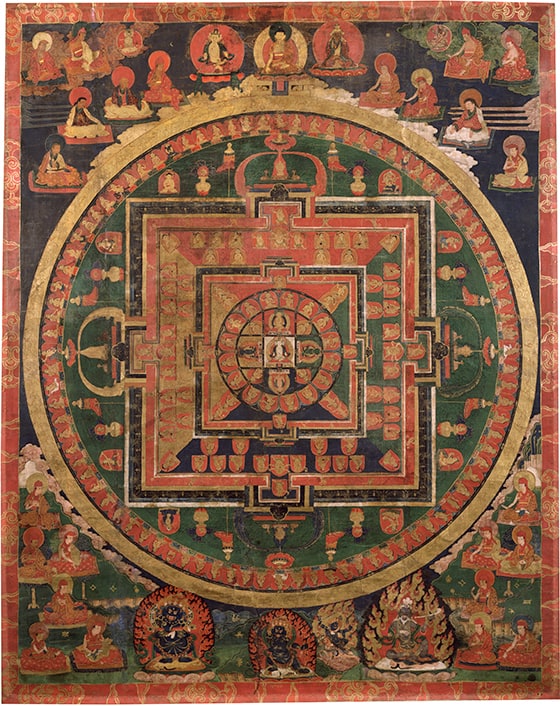
Follow the path to connect inner and outer worlds
A mandala is an aid for meditation, with the main object of veneration””in this case the Buddha Vairochana””in the center. In an initiation ritual, the meditator slowly approaches the center and transforms his or her body and mind into that of the deity.
A popular mandala in Tibetan Buddhism, the Vairochana mandala is also used for funerary rites, as the Buddha Vairochana removes the bad causes and effects generated during the deceased person’s life. It is considered auspicious to commission a mandala or a set of mandalas to bless a new temple, honor a deceased high lama, or simply acquire merit.

A mandala illustrates the structure of our world, outer and inner, including the five directions, five elements (space, water, earth, fire, air), five aggregates (matter, sensation, perception, volition, consciousness), five inner negativities (ignorance, anger, pride, desire, and jealousy) and their opposites, the five wisdoms of an enlightened mind. The colors of the sections follow the symbolism outlined in the yoga tantras, with blue in the east (where the meditator enters), yellow in the south, red in the west, and green in the north.
The mandala not only shows the outer cosmic and inner psychic universe but also reveals the path to an exalted state, to the inherent buddhahood that slumbers within every being, waiting to be discovered and awakened. The ultimate essence or unifying principle represented in the form of the central deity symbolizes this perfect world.
All painted mandalas are a blueprint of a three-dimensional reality. In this mandala, Vairochana sits on a small cube atop a larger cube, which rests on a crossed vajra. One must imagine the spokes of the vajra protruding from the four sides of the large cube, along with steep stairs””usually not depicted in a painted mandala””leading to the lower cube’s platform. Here one enters the mandala palace through the east gate, which is protected by guardian deities. Inside, deities sit on two pedestals.

Resting atop the lower cube with the crystal-like walls is the second cube, which one reaches by climbing a staircase that leads to another guarded gate. After passing this gate, one stands in front of the sixteen great bodhisattvas who sit in a circle facing the center.
A step higher, one sees eight deities””four female and four male””who also look toward the center, where an elevated white Vairochana sits with four heads looking in the four directions. He performs the mudra, or gesture, of meditation. This second cube of the mandala palace is also protected by a transparent wall. Each three-dimensional mandala has a roof, which is not shown in the painted version.
The whole mandala thus forms a kind of step pyramid, similar to those from Mesoamerica. It is a divine palace of jewels enclosed within a transparent bell-shaped structure. The second outermost blue ring, in which the vajras are inscribed in gold, represents this protective hood.
The outermost circle of flames, shown here in gold, provides an additional layer of protection, preventing any negative influence from entering the sanctuary.
Further Reading
Martin Brauen, Mandala: Sacred Circle in Tibetan Buddhism (New York: Arnoldsche and Rubin Museum of Art, 2009).
Michelle C. Wang, Mandalas in the Making: The Visual Culture of Esoteric Buddhism at Dunhuang (Leiden: Brill, 2018).
Kimiaki Tanaka, An Illustrated History of the Mandala: From Its Genesis to the Kalacakratantra (Somerville, MA: Wisdom Publications 2018).
Atsuro Seto, “Portable 3D Mandala Unpacking and Assembling – Atsuro Seto Dec. 2013.”
Atsuro Seto, “3-D Mandala,” D’Source.
About the Contributor
Martin Brauen, PhD, is a cultural anthropologist, curator, and author. From 2008 to 2011 he was chief curator at the Rubin Museum. Since his retirement he has independently curated several exhibitions, including Bill Viola: Passions at the Cathedral of Bern and The Cosmos at the Museum Rietberg, Zurich, and he recently published A Sameness Between Us: The Friendship of Charmion von Wiegand and Piet Mondrian in Letters and Memoirs.

Image credit
Detail of Sarvavid Vairochana Mandala; Tibet; 17th century; pigments on cloth; Rubin Museum of Art; gift of Shelley and Donald Rubin; C2006.66.346 (HAR 773)

